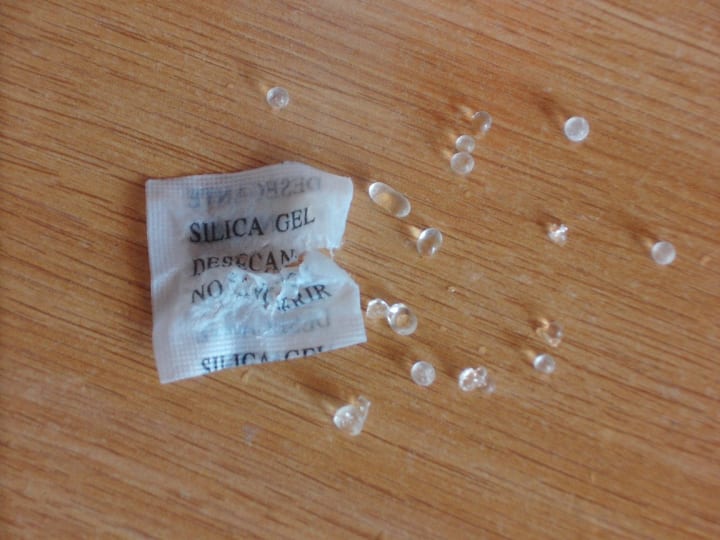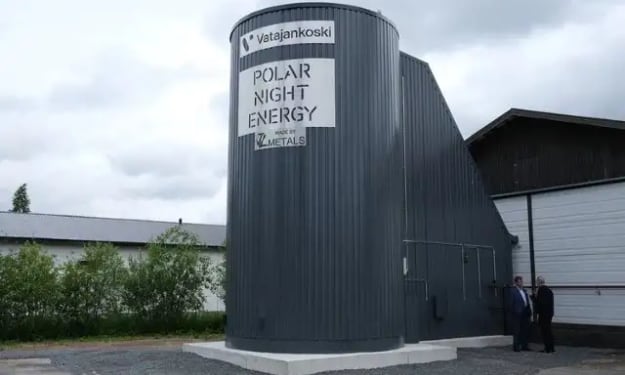Drinking Water from Desert Air
New gel technology could deliver it. 30% of the world's population live in dryland regions. Could this superhygroscopic polymer film make a difference?

You know that little sachet that you see in a box of electronics, or maybe in your bottle of vitamin supplements? That’s silica gel, and it’s there to absorb moisture and keep the contents dry.

Now researchers have taken this hygroscopic principle and concocted a polymer gel which can be used to extract water from ‘dryland’ air in quantities that make it practical at the personal level. They call it super hygroscopic polymer film (‘SHPF’).
Freshwater scarcity is increasingly perceived as a global systemic risk...two-thirds of the global population (4.0 billion people) live under conditions of severe water scarcity at least 1 month of the year. Nearly half of those people live in India and China. Half a billion people in the world face severe water scarcity all year round. — science.org
Water in desert air
There’s a surprising amount of water in desert air. That’s because hot air can hold high volumes of water. For example, in summer the desert air in Kuwait City can hold 15 grams of water in every cubic metre and Phoenix, Arizona, is not far behind.
‘It never rains in Las Vegas’ is a well known line in ‘Rain Man’ that’s been sampled in a couple of songs. In fact, it does rain in Las Vegas, but the point is that there is plenty of water in the air there although the air ‘feels’ very dry. That’s because the relative humidity is low.
Relative humidity
Some people think that this is about uncles who are always telling jokes, but that’s not so.
The relative humidity (‘RH’) of the atmosphere at a place is the percentage of saturation of the air at a given temperature and pressure. In simple terms, the air in a tropical rainforest is highly saturated and your skin will feel damp, but not so in a desert where higher temperatures reduce the relative saturation and your skin feels dry.
But there’s still a lot of water in the desert air.
The new gel technology
It may only be a gel but it’s a high-tech sustainable polymer gel that can harvest large quantities of water from the surrounding air, even in low-humidity conditions.
Developed by Youhong Guo and a team at the University of Texas at Austin, the low-cost material combines water-absorbing plant fibres with cellulose, which expels water when heat is applied.
There are already several porous materials available which can extract water from the air, but they only work in conditions of high relative humidity.
This new gel will work practically at relative humidity levels as low as 15% with 1 kg of the gel producing 6 litres of water per day using 14–24 cycles: extract-release-extract and so on.
The details
Materials and structure
The polymer material (matrix) contains a blend of konjac gum (‘KGM’) — a fibre widely used in Asian cuisine, based on a root vegetable— and hydroxypropyl cellulose (‘HPC’). As an aside, a form of HPC is used to manufacture artificial tears for people who have a dry eye condition.
The polymer matrix is dosed with a solution of lithium chloride which is a moisture-retaining salt.
Konjac gum has a high surface area with a ‘hierarchically porous structure’ — think of a sponge or activated carbon as an analogy. This structure provides a high water-collecting area while still being easily permeable to water vapour.
The clever bit
The really clever bit is that the HPC in the mix undergoes a phase change and the fibres twist when heated, squeezing the KGM — just like wringing out a sponge, but from within.
The captured water in the SHPF can be released by >70% within 10 min through mild heating at 60 °C under a wide range of RH — Nature Communications
Now I wondered about that ‘when heated’ phrase. Heating = energy input. Where does the energy come from? A generator? So why not just run a compressor and refrigeration unit to cool the air and release the water in a condenser?
I assume that it is just so much more efficient to use the gel and a heating plate- there is usually plenty of solar energy in dryland areas.
Making the gel
The team demonstrate that the polymer can easily be moulded using a simple casting method. The cheap and plentiful ingredients are mixed and two minutes after being poured into the mould the mixture is freeze-dried and peeled out. It is immediately ready for use.
There is plenty of scope for further research in gel thicknesses and other details to improve yields.
A practical design
In the paper in Nature Communications, the team present a design for a practical water collection system. They built the unit which requires inexpensive components and fabrication and it appears to deliver the water in a sustainable way.
This is what the authors concluded (I’ve left out the data to make it easier to read):
Featured with high water uptake under low RHs at outdoor conditions (~5.5 L per kg per day… low cost of materials… facile and scalable synthesis, and overall environmental friendliness, SHPFs hold promise for future sustainable implementation.
At RH levels of 30% the unit can produce 13 litres of water per kilogram of material in use.
Everything degrades eventually — it’s entropy, as my rusting boat testifies — but I didn’t read anything about how many cycles this material can be used for before it ‘wears out’, so to to speak. It was typically going through 14–24 cycles per day in the testing.
Let’s hope it’s highly durable. The world needs solutions like these.
Water is precious and becoming more so
First-world city dwellers can be a bit blase about water, but it is precious. I live on a boat and water is something that I take seriously. I don’t have a watermaker - won’t have a water maker - which uses energy to inefficiently desalinate sea water.
The SHPF research paper can be read in full in Nature Communications.
You can read about my personal water challenges here:
***
This story was first published in Medium on 8 July 2022
About the Creator
James Marinero
I live on a boat and write as I sail slowly around the world. Follow me for a varied story diet: true stories, humor, tech, AI, travel, geopolitics and more. I also write techno thrillers, with six to my name. More of my stories on Medium






Comments
There are no comments for this story
Be the first to respond and start the conversation.